It's that time of the year again:
The time when the hockey season starts in Germany... which means: I have to prepare tons of video clips for the new season.
Which is also the reason I'm not often visiting the forums - it's simply a lack of time.
However, this doesn't mean I'm also lacking time to work on the Pyra. It means I'm having less time for sleep than usual...
Thankfully, the season has now started, all clips have been prepared, so I can finally give you updates about what happened in Pyra-Land!
As the keymats have a leadtime of 12 weeks, I'm trying to get everything else done within these 12 weeks as well!
Various tests of the PCBs
I've assembled another 8 Pyras now which will be used to do a burn-in test of the new PCBs next week.
In this test, all Pyras are booted off an SD Card. They will log the remaining battery capacity and voltage, the current CPU speed, temperatures as well as the uptime onto the SD-Card. So if they crash, freeze or whatever, I can see when that happened in the logfile.
Hopefully, they won't crash, but if they do, it might be related to the remaining battery capacity (as there's nothing that shuts down the OS if the battery gets too empty at the moment).
Afterwards, I will also make a test with full CPU load and use an infrared camera to check on the heating.
Two of the units have been built a bit different:
One has two heatsinks installed. According to Julianos simulation, this shouldn't make a big difference - but as such complex simulations are not always 100% correct, I'd like to test that anyways.
And another one has a copper plate instead of an aluminium plate installed, just to see, if there's any difference in heat distribution.
I also grabbed an incredibly useful small USB power tester.
This can be used to check the power the connected device is pulling.
It allowed a quick test of the 22 prototype PCBs I had here - I didn't even need to boot them up!
Here's how:
First, you need to know that the OMAP5 boots up right away once you connect it to a power supply (like the OMAP3).
It looks for a bootloader on various media: SD Card slot, eMMC, USB.
If it doesn't find one, it continues the cycle, until it finds a bootloader.
So connecting the USB power tester to a prototype that doesn't have any bootloader anywhere looks like this:
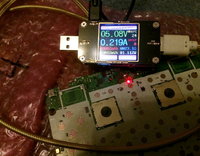
Power consumption always cycles between 0.204A and 0.225A. This is because while looking for a bootloader, power varies a bit.
This quick test confirms within seconds, that there's no short circuit on the mainboard (at least none that increases the power consumption) and that the CPU board at least tries to boot, so the CPU is working.
And yes, one of the 22 PCBs actually had a slightly higher power consumption:
It was between 0.260A and 0.280A - something seems to be wrong here!
But is it the CPU board or the mainboard?
Easy way to test: Remove the CPU Board!
And this is what happened with that board without CPU-Board:
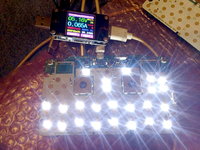
It's firing up the LEDs! That shouldn't happen!
This is what a different mainboard looks like without CPU board:
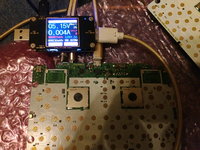
Also take note of the power consumption, which is a LOT less than with that "broken" mainboard.
While I don't know what exactly is wrong with that mainboard (it even boots without issues, but we haven't tested all components), that quick check actually showed right away that something is wrong.
Well, but that means:
ALL CPU Boards that have been produced at least start the CPU.
And only one mainboard has an issue. That would be an AWESOME failure rate. But more tests will be needed.
With that power consumption tester, I could do some more quick tests.
This is a Pyra booted up with no LCD connected:
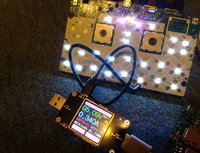
The same one with an LCD connected and keyboard brightness set to maximum:
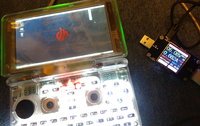
With keyboard LEDs disabled:
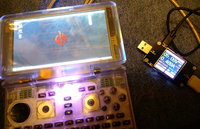
And with keyboard LEDs set to minimum brightness:
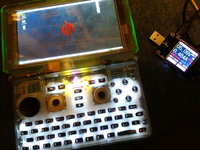
Usually, minimum keyboard brightness is enough. You can easily see all keys in the dark with that one and you won't need the LEDs enabled when you're using it in a bright surrounding.
While the CPU is doing nothing spectacular at the moment, everything has been enabled:
Wifi, Bluetooth, USB-Ports, all LEDs, etc.
Things we could switch off to save some more power.
With normal usage, the battery should last around 9 hours right now - and this is also what Askarus experience in daily usage has been.
However, powersaving can be improved A LOT. You can also lower the maximum clockrate or disable a CPU if you want to have more battery time - it will still be faster than the Pandora is right now.
This is okay for a start I think (the Pandora had 8 hours battery time at the beginning), but there's still a lot of improvement possible.
Okay, so much for the current status of the tests, let's head to...
The cases
FormAction has reopened the factory after the summer break and should hopefully finish those cases soon, but right now I'm concentrating on Uniqueplast (the company where we'll move the production to).
I'm in good contact with the one of the junior CEOs (we also communicate quickly via messengers and I get almost instant replies to any questions - and he is also a hardcore gamer, so he knows how shoulder buttons should feel...).
There's an exhibition coming up in Germany, the Fakuma International.
It's an exhibition for industrial plastic processing.
Both CEOs from Uniqueplast will be there - and I'll go there as well, so we can look together for different plastic materials and hopefully find the perfect one for the Pyra.
This will be pretty interesting - and it's nice to see they actually are interested in what they're doing (and new developments), which is something that was sadly lacking from our current company...
The exhibition takes place in October. If we can get proper plastic there, we can produce the cases in November and have them in time with the keymats.
Please note the disclaimer: These are possible dates, but it's what I'm trying to achieve.
Other things...
Nikolaus is working hard on other software-based low-level stuff (for example, debugging why the Pyra hangs when you reboot it or why the VBUS detection of the charger chip doesn't work reliable yet) and is making good progress there.
I'll try to finish the tests as fast as possible, as these units would then be ready for our Pyra Prototype preorderers (yep, finally!)
As usual, feel free to throw any questions here at me and thanks again for your interest and support.
I'll keep you updated!
The time when the hockey season starts in Germany... which means: I have to prepare tons of video clips for the new season.
Which is also the reason I'm not often visiting the forums - it's simply a lack of time.
However, this doesn't mean I'm also lacking time to work on the Pyra. It means I'm having less time for sleep than usual...
Thankfully, the season has now started, all clips have been prepared, so I can finally give you updates about what happened in Pyra-Land!
As the keymats have a leadtime of 12 weeks, I'm trying to get everything else done within these 12 weeks as well!
Various tests of the PCBs
I've assembled another 8 Pyras now which will be used to do a burn-in test of the new PCBs next week.
In this test, all Pyras are booted off an SD Card. They will log the remaining battery capacity and voltage, the current CPU speed, temperatures as well as the uptime onto the SD-Card. So if they crash, freeze or whatever, I can see when that happened in the logfile.
Hopefully, they won't crash, but if they do, it might be related to the remaining battery capacity (as there's nothing that shuts down the OS if the battery gets too empty at the moment).
Afterwards, I will also make a test with full CPU load and use an infrared camera to check on the heating.
Two of the units have been built a bit different:
One has two heatsinks installed. According to Julianos simulation, this shouldn't make a big difference - but as such complex simulations are not always 100% correct, I'd like to test that anyways.
And another one has a copper plate instead of an aluminium plate installed, just to see, if there's any difference in heat distribution.
I also grabbed an incredibly useful small USB power tester.
This can be used to check the power the connected device is pulling.
It allowed a quick test of the 22 prototype PCBs I had here - I didn't even need to boot them up!
Here's how:
First, you need to know that the OMAP5 boots up right away once you connect it to a power supply (like the OMAP3).
It looks for a bootloader on various media: SD Card slot, eMMC, USB.
If it doesn't find one, it continues the cycle, until it finds a bootloader.
So connecting the USB power tester to a prototype that doesn't have any bootloader anywhere looks like this:

Power consumption always cycles between 0.204A and 0.225A. This is because while looking for a bootloader, power varies a bit.
This quick test confirms within seconds, that there's no short circuit on the mainboard (at least none that increases the power consumption) and that the CPU board at least tries to boot, so the CPU is working.
And yes, one of the 22 PCBs actually had a slightly higher power consumption:
It was between 0.260A and 0.280A - something seems to be wrong here!
But is it the CPU board or the mainboard?
Easy way to test: Remove the CPU Board!
And this is what happened with that board without CPU-Board:

It's firing up the LEDs! That shouldn't happen!
This is what a different mainboard looks like without CPU board:

Also take note of the power consumption, which is a LOT less than with that "broken" mainboard.
While I don't know what exactly is wrong with that mainboard (it even boots without issues, but we haven't tested all components), that quick check actually showed right away that something is wrong.
Well, but that means:
ALL CPU Boards that have been produced at least start the CPU.
And only one mainboard has an issue. That would be an AWESOME failure rate. But more tests will be needed.
With that power consumption tester, I could do some more quick tests.
This is a Pyra booted up with no LCD connected:

The same one with an LCD connected and keyboard brightness set to maximum:

With keyboard LEDs disabled:

And with keyboard LEDs set to minimum brightness:

Usually, minimum keyboard brightness is enough. You can easily see all keys in the dark with that one and you won't need the LEDs enabled when you're using it in a bright surrounding.
While the CPU is doing nothing spectacular at the moment, everything has been enabled:
Wifi, Bluetooth, USB-Ports, all LEDs, etc.
Things we could switch off to save some more power.
With normal usage, the battery should last around 9 hours right now - and this is also what Askarus experience in daily usage has been.
However, powersaving can be improved A LOT. You can also lower the maximum clockrate or disable a CPU if you want to have more battery time - it will still be faster than the Pandora is right now.
This is okay for a start I think (the Pandora had 8 hours battery time at the beginning), but there's still a lot of improvement possible.
Okay, so much for the current status of the tests, let's head to...
The cases
FormAction has reopened the factory after the summer break and should hopefully finish those cases soon, but right now I'm concentrating on Uniqueplast (the company where we'll move the production to).
I'm in good contact with the one of the junior CEOs (we also communicate quickly via messengers and I get almost instant replies to any questions - and he is also a hardcore gamer, so he knows how shoulder buttons should feel...).
There's an exhibition coming up in Germany, the Fakuma International.
It's an exhibition for industrial plastic processing.
Both CEOs from Uniqueplast will be there - and I'll go there as well, so we can look together for different plastic materials and hopefully find the perfect one for the Pyra.
This will be pretty interesting - and it's nice to see they actually are interested in what they're doing (and new developments), which is something that was sadly lacking from our current company...
The exhibition takes place in October. If we can get proper plastic there, we can produce the cases in November and have them in time with the keymats.
Please note the disclaimer: These are possible dates, but it's what I'm trying to achieve.
Other things...
Nikolaus is working hard on other software-based low-level stuff (for example, debugging why the Pyra hangs when you reboot it or why the VBUS detection of the charger chip doesn't work reliable yet) and is making good progress there.
I'll try to finish the tests as fast as possible, as these units would then be ready for our Pyra Prototype preorderers (yep, finally!)
As usual, feel free to throw any questions here at me and thanks again for your interest and support.
I'll keep you updated!


